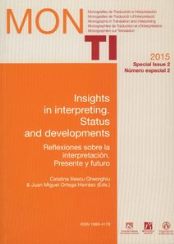Current dilemmas in court interpreting: improving quality and access through smarter testing and administration protocols
Main Article Content
Abstract
Downloads
Article Details
The documents contained in these directories are included by the contributing authors as a means to ensure timely dissemination of scholarly and technical work on a non-commercial basis. It is understood that all persons copying this information will adhere to the terms and constraints invoked by each author's copyright. These works may not be reposted without the explicit permission of the copyright holder.
References
Brummond, Patrick & Karen Mikshowsky. (2012) District 7 Court Interpreter Pilot Program Report. Unpublished report.
Capati, Carmel. (2012) Minutes of the October 26th, 2012 Meeting of the Committee to Improve Interpretation and Translation in the Wisconsin Courts. Print.
Capati, Carmel. (2011) 2011 Court Interpreter Program Manager’s End-of-Year Report Submitted to the Committee to Improve Interpreting & Translation in the Wisconsin Courts. Unpublished report.
Increasing Access to Justice for Limited English Proficient Asian Pacific Americans. (2007). Retrieved September 13, 2013, from National Asian Pacific American Bar Association website: www.napaba.org
National Center for State Courts. (2013) A National Call to Action. Access to Justice for Limited English Proficient Litigants: Creating Solutions to Language Barriers in State Courts. Electronic version available at: http://www.ncsc.org/services-and-experts/areas-of-expertise/language-access/~/media/files/pdf/services%20and%20experts/areas%20of%20expertise/language%20access/call-to-action.ashx
National Center for State Courts. (2012) Court Interpreter Oral Exam: Overview Electronic version available at: http://www.ncsc.org/EducationandCareers/~/media/Files/PDF/Education%20and%20Careers/State%20Interpreter%20Certification/Overview%20of%20the%20Oral%20Exam%20REV7-31-2012.ashx
Wallace, Melissa. (2013) “Rethinking Bifurcated Testing Models in the Court Interpreter Certification Process.” In: Tsagari, Dina & Roelof Van Deemter (eds.) (2013) Assessment Issues in Language Translation and Interpreting. Frankfurt Am Main: Peter Lang GmbH, pp. 67-83.
Wallace, Melissa. (2012) Predictors of Successful Performance on U.S. Consortium Court Interpreter Certification Exams. Universidad de Alicante, Spain. Unpublished Ph.D. thesis.
Wallace, Melissa. (2010) Sight Translation in Wisconsin Courts. Thesis. Universidad de Alicante, Spain. Unpublished DEA (Diploma de Estudios Avanzados) thesis.


